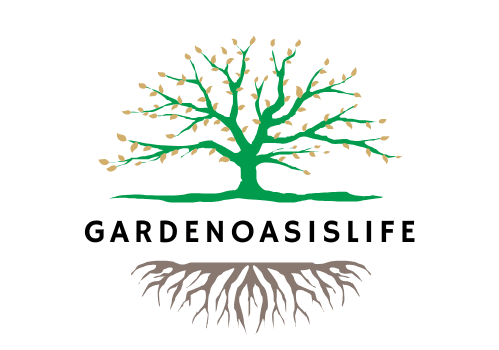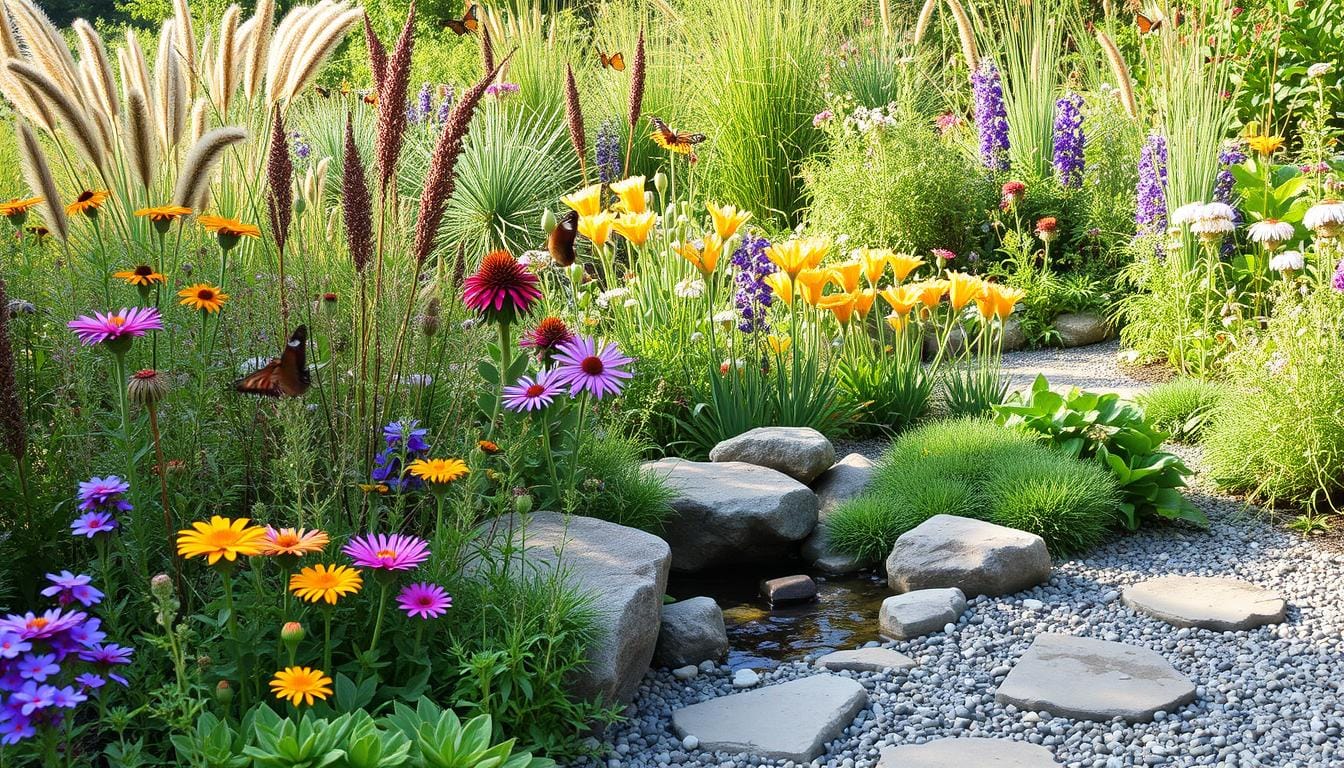Beautiful Gardens Without Lawns: Natural Landscaping Ideas
In recent years, the traditional lawn has faced criticism for its environmental harm and upkeep needs. As people grow more aware of their ecological impact, they seek sustainable and easy-to-care-for landscaping options. This article delves into the idea of gardens without lawns, offering natural landscaping ideas to turn your outdoor area into a lush, eco-friendly haven.
Key Takeaways
- Discover the benefits of transitioning from traditional lawns to natural landscaping
- Explore a variety of lawn-free garden designs that promote sustainability and local ecosystems
- Learn about water-wise landscaping techniques, such as xeriscaping, to conserve precious resources
- Incorporate native plants and create habitats that support diverse wildlife
- Combine beauty and function by incorporating edible elements into your garden design
Why Traditional Lawns Are Becoming Obsolete
The world is waking up to the harm our choices do to the environment. Traditional lawns, once a sign of suburban pride, are now seen as wasteful. They use a lot of water and harm the planet.
Environmental Impact of Lawn Maintenance
Keeping a lawn green needs a lot of water, taking from our precious freshwater. The use of chemicals like fertilizers and pesticides harms local wildlife. It messes with the balance of nature.
Water Conservation Challenges
In areas hit by drought, lawns use too much water. As water becomes scarcer, people are looking for ways to save it. They’re turning to water-wise gardening instead.
Chemical Usage Concerns
Using chemicals to keep lawns perfect is bad for us and the planet. These chemicals can pollute soil, water, and air. They’re a danger to animals and people.
More people want sustainable landscaping that’s good for the earth. They want gardens that are beautiful without harming nature. This shift is making traditional lawns less popular.
Gardens Without Lawns: A Sustainable Alternative
Gardens without lawns are becoming more popular for eco-friendly gardening and low-maintenance landscapes. These lawn-free gardens use less water and need less upkeep. They help create beautiful outdoor spaces that support nature and are good for the environment.
One big advantage of these gardens is they use less water. Lawns often need a lot of watering, especially in dry areas. But, using native plants and drought-resistant species can cut down water use a lot.
Also, low-maintenance landscapes mean no more mowing, edging, and other hard work. This saves time and helps the environment by reducing emissions from lawn equipment. Gardeners can enjoy their spaces more because they need less care.
Switching to gardens without lawns is a step towards greener gardening. It helps save resources, supports nature, and makes outdoor spaces beautiful and easy to care for. This way, homeowners can help the planet and enjoy their gardens more.
Native Plant Landscapes: Building Local Ecosystems
Native plant gardens are becoming more popular for sustainable landscaping. They make your outdoor spaces look great and help local ecosystems and wildlife.
Best Native Plants for Your Region
Choosing the right native plants for your garden is key. Native plant gardens need little care because they fit right into your local environment. They use less water and fertilizer.
- Find out which native plants are best for your area and what they need to grow.
- Talk to local nurseries or native plant groups to find the top drought-tolerant plantings for your region.
- Use a mix of native plants to make a lively garden that draws in pollinators and other wildlife.
Creating Wildlife Habitats
Native plant gardens are not just pretty; they’re also a lifeline for local wildlife. By growing a variety of native plants, you help birds, butterflies, and other pollinators thrive.
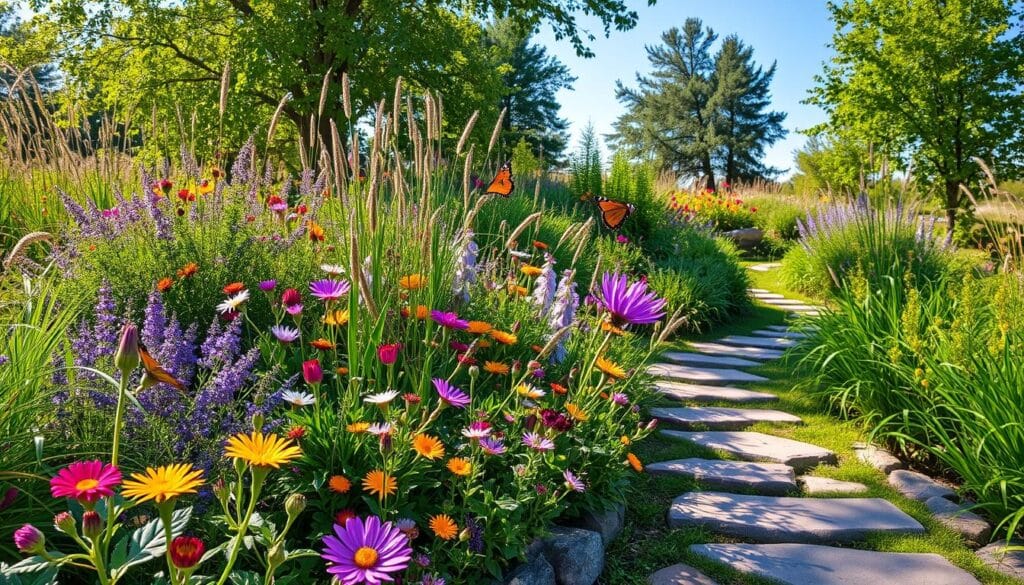
Seasonal Planning with Native Species
Native plant gardens offer beauty all year round. By picking plants that bloom at different times, your garden stays interesting and full of life all season.
“Incorporating native plants into your landscape is a simple yet powerful way to create a self-sustaining, ecologically-balanced oasis that celebrates the natural beauty of your local environment.” – Jane Doe, Landscape Architect
Xeriscaping: Beauty in Water-Wise Design
In areas where water is scarce, the old idea of a lush, green lawn is fading away. Xeriscaping brings a new way to landscape that’s both beautiful and water-efficient. It uses drought-resistant plants, smart watering, and soil care to make gardens that need little water.
The core of xeriscaping is choosing plants that fit the local climate. These plants need less water, food, and care, perfect for those who care about water. By picking a variety of xeriscaping plants, gardens can look amazing and feel like part of nature.
- Focus on drought-tolerant, native plants
- Improve soil quality to enhance water retention
- Utilize efficient irrigation systems, such as drip lines
- Strategically group plants with similar water needs
- Incorporate mulch to reduce evaporation
Xeriscaping also means managing water well. This includes using drip irrigation, rain barrels, and smart plant placement. These steps help gardens look great while using less water.
“Xeriscaping is not just about water conservation – it’s about creating a beautiful, sustainable garden that reflects the natural beauty of the region.”
As water becomes more precious worldwide, xeriscaping is a smart and pretty choice. It lets us make gardens that save water and also bring joy and wonder.
Creating Natural Pathways and Gathering Spaces
As we move away from traditional lawns, we need to plan our outdoor spaces carefully. We should choose materials for pathways and create seating areas. Natural borders are also key to a cohesive, low-maintenance landscape.
Material Selection for Pathways
Choosing the right materials for pathways is crucial in sustainable landscaping. Opt for permeable surfaces like decomposed granite, permeable pavers, or natural stone. These allow water to infiltrate and reduce runoff. They’re eco-friendly and visually pleasing, unlike concrete or asphalt.
Integrating Seating Areas
Make your sustainable landscaping inviting with seating areas. Use natural stone, wood, or recycled materials for benches, walls, or platforms. These spaces encourage relaxation and connect us with nature.
Natural Border Solutions
Use native plants, shrubs, or boulders and rocks for natural borders. They define spaces and add to the landscape’s beauty and ecology. Strategically placed borders guide foot traffic and provide interest all year.
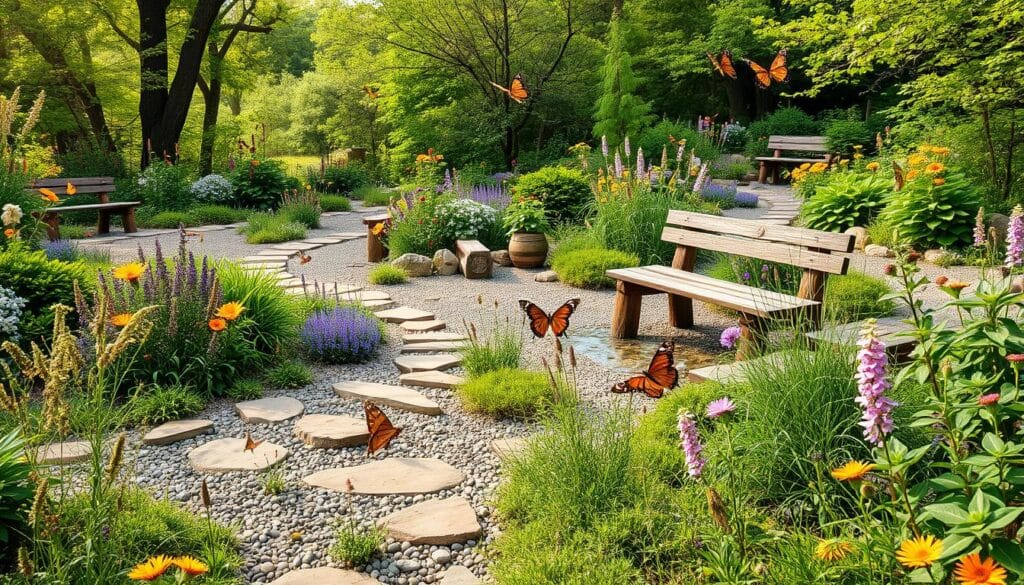
By carefully adding these elements, we can create beautiful outdoor spaces. These spaces blend well with sustainable landscaping and reduce the need for lawns.
Ground Cover Alternatives for Traditional Grass
More people are looking for ways to cut down on traditional grass lawns. They want drought-tolerant and easy-to-care-for ground covers instead. These options make outdoor spaces look better and help the environment by saving water and cutting down on chemicals.
Versatile Groundcovers for Every Garden
There are many ground covers to choose from, like flowering ones and tough succulents. They fit different climates and garden styles. Here are some good choices:
- Clover – It’s tough, needs little water, and looks like a soft green carpet.
- Sedum – These succulents love dry, sunny spots and come in many colors and textures.
- Thyme – It’s a fragrant herb that’s easy to walk on and keeps your garden looking neat.
- Moss – It’s lush, loves shade, and needs almost no care, making your garden feel calm and natural.
| Ground Cover | Water Needs | Sunlight Preference | Maintenance Level |
|---|---|---|---|
| Clover | Low | Full Sun to Partial Shade | Low |
| Sedum | Low | Full Sun | Low |
| Thyme | Low | Full Sun | Low |
| Moss | Moderate | Partial to Full Shade | Low |
Using these lawn alternatives and drought-tolerant plantings, you can make a garden that’s beautiful and good for the planet. It will need less water and care.
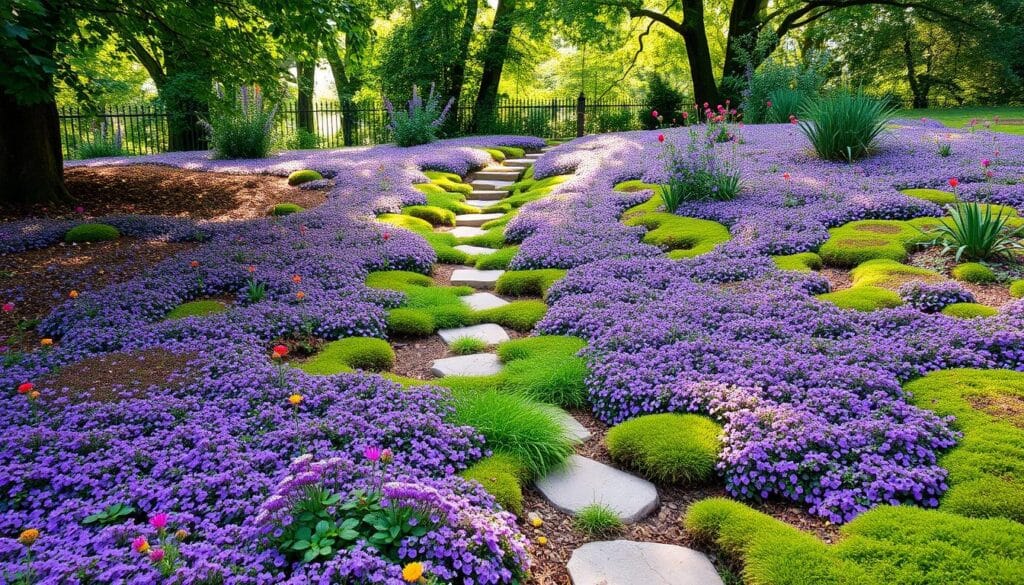
Incorporating Rock Gardens and Succulents
Turning your lawn-free space into a beautiful oasis is simple with rock gardens and xeriscaping plants. These features save water and bring charm to your yard. They add depth and texture, making your outdoor area more appealing.
Choosing the Right Rocks
Choosing the right rocks is crucial for a stunning rock garden. Use rocks of different sizes, shapes, and colors. Big boulders can be the base, while smaller stones fill gaps for a natural look.
Drought-Resistant Plant Selection
- Use drought-tolerant plantings like succulents and cacti for your rock garden. They love dry, well-drained soil.
- Native plants are best because they need little water and care. They fit your local climate well.
- Combine different textures, colors, and bloom times for a lively, changing landscape.
Maintenance Tips for Rock Gardens
- Keep your rock garden weed-free by regularly removing unwanted plants.
- Put a thin layer of gravel or crushed rock around plants. It keeps moisture in and weeds out.
- Watch for signs of stress or disease in your plants. Prune or transplant as needed to keep them healthy.
Adding rock gardens and drought-tolerant plants to your lawn-free space makes a stunning, eco-friendly oasis. It’s easy to care for and looks great.
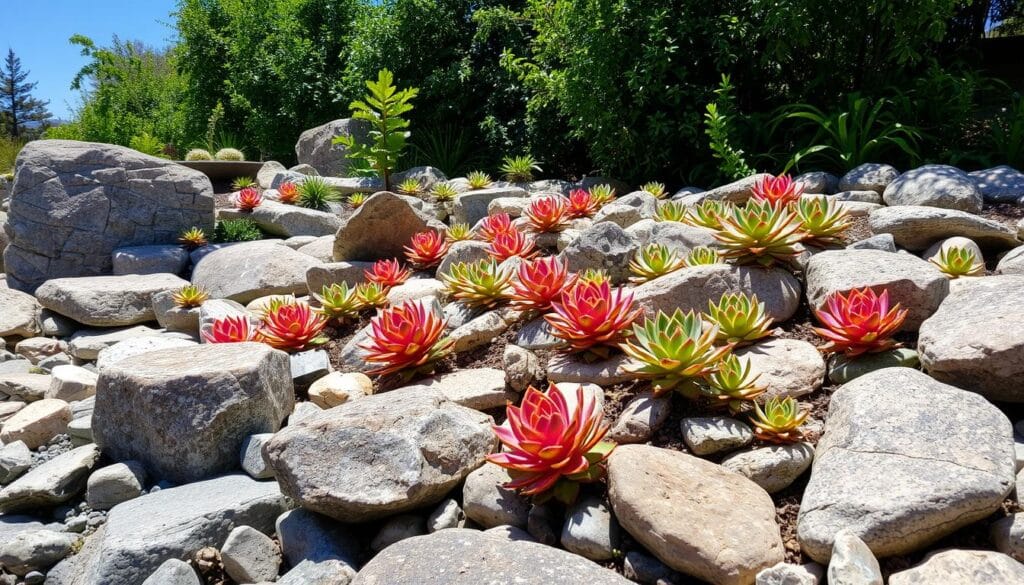
Edible Landscapes: Combining Beauty with Function
In the quest for sustainable landscaping, permaculture design has become very popular. It combines edible plants with ornamental landscapes. This creates a beautiful and useful space.
Permaculture uses native, drought-tolerant plants. These plants make your outdoor space look great and help local ecosystems. By choosing a variety of edible plants, you can turn your lawn into a lively, sustainable landscaping spot. It offers beauty and fresh, homegrown food.
- Fruit trees and shrubs, like blueberries, raspberries, and figs, add beauty and taste.
- Herb gardens, with their smell and use in cooking, fit well in flower beds.
- Vegetable plants, such as tomatoes, peppers, and leafy greens, make your garden look good and work well.
The secret to great edible landscaping is finding the right mix of looks and use. Arrange your plants well and use design elements like texture and color. This way, your garden will be both beautiful and productive.
| Edible Plant | Ornamental Value | Cultivation Needs |
|---|---|---|
| Blueberry Bushes | Vibrant fall foliage, delicate white flowers | Acidic soil, full sun to partial shade |
| Kale | Striking leaf shapes and colors, works well in flower beds | Well-drained soil, full sun to partial shade |
| Rosemary | Fragrant, needle-like foliage, blue flowers | Well-drained soil, full sun |
By using sustainable landscaping and adding edible plants, you can make a beautiful and useful space. It will feed your senses and body.
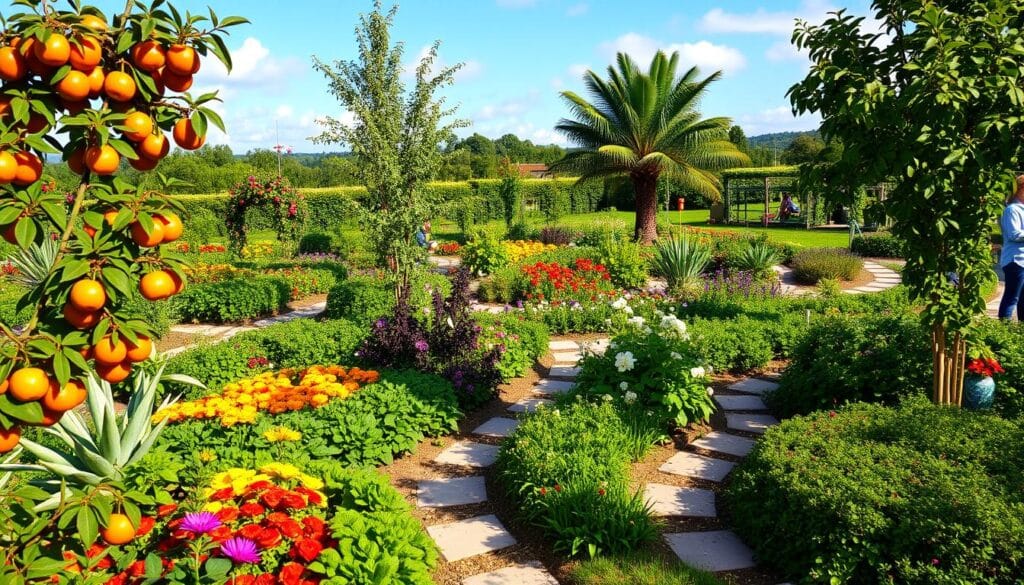
“Edible landscapes are not only beautiful, but they also promote self-sufficiency and reduce our reliance on industrialized food systems.”
Water Features and Rain Gardens
Adding water elements to your garden can make it feel fresh and natural. You can create a peaceful pond or a rain garden to handle stormwater. These features make your garden look better and help the environment.
Natural Pond Creation
Building a pond attracts wildlife and makes your backyard peaceful. Use native plants and avoid chemicals to keep the water clean. Add sloping edges and different depths to support various species.
Rain Garden Design Basics
- Choose a spot that catches runoff from roofs and driveways.
- Pick plants that can handle flooding and dry spells.
- Make sure the garden slopes gently and has different plant layers.
- Have an overflow to stop water from pooling during heavy rains.
Water Conservation Techniques
To make your water features sustainable, use these tips:
- Install rainwater harvesting systems to save rainwater for plants.
- Choose plants that need less water and water them wisely.
- Use surfaces that let water soak in to recharge groundwater.
| Water Conservation Technique | Benefits |
|---|---|
| Rainwater Harvesting | Reduces the need for city water, gives plants a fresh water source. |
| Drought-Resistant Landscaping | Uses less water, makes your garden strong and adaptable. |
| Permeable Surfaces | Helps water soak into the ground, recharges it, and cuts down on pollution. |
By adding water features and rain gardens to your garden, you can make it beautiful and eco-friendly. This approach enhances your water-wise gardening and sustainable landscaping efforts.
Four-Season Interest Without Grass
Creating a lively, easy-to-care-for garden doesn’t need a traditional lawn. By picking the right native plant gardens and adding smart hardscaping, you can make a stunning landscape. This landscape will be beautiful all year round.
For a garden that looks good all seasons, choose a variety of plants. Native plant gardens are great because they grow well here and need little care. They include colorful perennials, evergreen shrubs, and ornamental grasses. These plants add interest all year without the hassle of a lawn.
Hardscaping, like paths, seating, and rock gardens, is also key. These features add shape and beauty to your garden. They also create spots that catch the eye, even when plants are not in bloom.
By mixing the right plants and hardscaping, you can have a garden that’s both beautiful and easy to maintain. It will offer interest all year without needing a traditional lawn.
Maintenance and Care for Lawn-Free Gardens
Keeping a lawn-free garden might seem hard at first. But, with the right steps, it can be easy and rewarding. By using low-maintenance landscapes and eco-friendly gardening methods, you can make a beautiful outdoor space that needs little care.
Seasonal Maintenance Schedule
Lawn-free gardens need less upkeep than regular grass lawns. You won’t have to mow every week. Instead, you’ll do tasks like pruning, mulching, and weeding seasonally. Make a plan for each season to keep your garden looking great all year.
Organic Pest Control Methods
Use natural, eco-friendly gardening ways to fight pests in your garden. Try organic deterrents like companion planting, beneficial insects, and natural repellents. This method keeps your plants safe and helps the environment.
Pruning and Plant Care
Pruning and caring for your plants are key for a healthy, beautiful low-maintenance landscape. Learn how to prune your plants well and stick to a schedule. Also, take care of your plants by watering, mulching, and watching for diseases. This way, your garden will flourish without needing a lawn.
